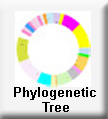Hemicycliophora typica
de Man, 1921
Female : 1.2 mm; a = 20; b = 6.0; V – 5284
Body marked by 256-280 annules. Larval cuticle fitting
rather closely. Lateral fields simple without longitudinal markings.
Lip region rounded with 2 annules in last larval cuticle, but none on lips
proper. Spear extending through 19-26 annules, the basal knobs projecting
slightly backward. Basal bulb of esophagus slightly clavate.
Excretory pore opposite beginning of intestine. Hemizonid small but
distinct, adjacent to excretory pore. Intestinal cells vacuolated,
containing small nuclei. Ovary outstretched, about one-half as long
as body. Uterus with prominent spermatheca. Vulva with protuberant
posterior lip, located at a ventral contraction of the body. Anus
very obscure, 14-17 annules posterior to vulva. Tail at first convex-conoid,
then elongate conoid to the small sharp terminus.
Male : 1.0 mm; a = 34; b = 6.2; c = 5.1; T – 42
Cuticle marked by fine but distinct striae. Lateral fields
with 3 lines forming 2 bands which extend from near the head to near the
middle of tail. Lip region slightly expanded. Spear absent.
Pharynx sometimes appearing as an open chamber with slightly sclerotized
walls. Esophagus a slender tube with nerve ring near its base.
Excretory pore opposite base of esophagus. Hemizonid very distinct,
slightly anterior to excretory pore. Intestinal cells vacuolated,
with scattered granules. Testis outstretched, slightly less than
one-half body length. Spicula semi-circular, as
illustrated. Bursa broad, about 3 times as long as body width.
Tail conoid to the small pointed terminus.
DIAGNOSIS. – Hemicycliophora typica is distinctive because
of the tail form, the simple lateral fields and the semi-circular spicula.
TYPE LOCALITY. – Cultivated field, Zeeland, Holland.
NEOTYPE. – Female No. 2, slide Hemicycliophora 6.
NEOALLOTYPE. – Male No. 1, slide Hemicycliophora 6 a,
University of California, Berkeley.
This
species included in the Criconematid Project
DNA Sequence Obtained
specimen:
collected:





